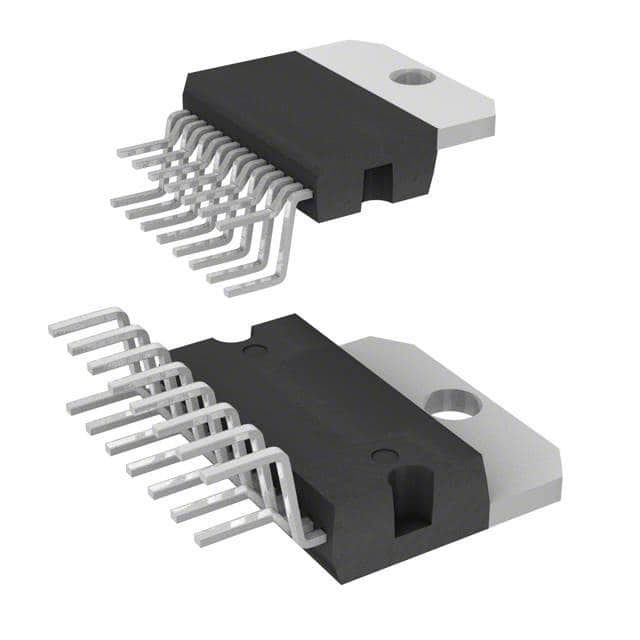E-L298N
Product Overview
Category: Integrated Circuit (IC)
Use: Motor Driver
Characteristics: - Dual H-Bridge motor driver - Can control two DC motors or one stepper motor - Designed for use in robotics and automation projects
Package: Multiwatt15
Essence: The E-L298N is a versatile motor driver IC that allows precise control of DC motors and stepper motors, making it an essential component in various robotic and automation applications.
Packaging/Quantity: The E-L298N is typically sold individually in a standard package.
Specifications
- Operating Voltage: 5V - 46V
- Maximum Continuous Current per Channel: 2A
- Peak Current per Channel: 3A
- Logic Voltage: 5V
- Number of Channels: 2
Detailed Pin Configuration
The E-L298N has a total of 15 pins. Here is the detailed pin configuration:
- Enable A - Enables the motor connected to channel A
- Input 1A - Controls the direction of rotation for motor A
- Input 2A - Controls the direction of rotation for motor A
- Output 1A - Connects to one terminal of motor A
- Output 2A - Connects to the other terminal of motor A
- VCC - Power supply voltage input (5V)
- Ground - Common ground for power supply and logic
- Ground - Common ground for power supply and logic
- Output 2B - Connects to one terminal of motor B
- Output 1B - Connects to the other terminal of motor B
- Input 2B - Controls the direction of rotation for motor B
- Input 1B - Controls the direction of rotation for motor B
- Enable B - Enables the motor connected to channel B
- Logic Voltage (5V) - Connects to the logic voltage source
- VCC - Power supply voltage input (5V)
Functional Features
- Dual H-Bridge configuration allows independent control of two motors
- Built-in protection diodes for inductive loads
- Adjustable current limiting feature for protecting the motors
- Enable pins for each channel allow selective motor control
- Supports both forward and reverse rotation of motors
- Can be used with various microcontrollers and Arduino boards
Advantages and Disadvantages
Advantages: - Versatile motor driver suitable for a wide range of applications - Precise control over motor speed and direction - Built-in protection features ensure safe operation - Compatible with popular microcontrollers and development boards
Disadvantages: - Limited maximum current per channel (2A) - Requires external power supply for motor operation
Working Principles
The E-L298N operates on the principle of an H-Bridge circuit. It uses a combination of transistors and diodes to control the flow of current through the connected motors. By controlling the input signals to the H-Bridge, the E-L298N can determine the direction and speed of the motors.
Detailed Application Field Plans
The E-L298N finds extensive use in various fields, including: 1. Robotics: Used to control the movement of robot arms, wheels, and other motorized components. 2. Automation: Employed in automated systems for precise control of motors in conveyor belts, CNC machines, and industrial equipment. 3. Electric Vehicles: Integrated into electric vehicle control systems for motor control and regenerative braking.
Detailed and Complete Alternative Models
- L293D: Similar dual H-Bridge motor driver IC with lower current ratings.
- TB6612FNG: Compact motor driver IC with built-in protection features.
- DRV8833: Dual H-Bridge motor driver IC with low voltage operation capability.
These alternative models offer similar functionality to the E-L298N and can be used as replacements depending on specific requirements.
Word count: 530 words
Liệt kê 10 câu hỏi và câu trả lời thường gặp liên quan đến ứng dụng E-L298N trong giải pháp kỹ thuật
Sure! Here are 10 common questions and answers related to the application of E-L298N in technical solutions:
Q: What is the E-L298N? A: The E-L298N is a dual H-bridge motor driver module commonly used to control DC motors or stepper motors in various technical applications.
Q: How does the E-L298N work? A: The E-L298N works by providing a way to control the direction and speed of motors using PWM signals and H-bridge circuitry.
Q: What voltage range does the E-L298N support? A: The E-L298N typically supports a wide voltage range, usually from 5V to 35V, making it suitable for a variety of motor types.
Q: Can the E-L298N drive both DC motors and stepper motors? A: Yes, the E-L298N can be used to drive both DC motors and bipolar stepper motors.
Q: How many motors can be controlled using the E-L298N? A: The E-L298N can control up to two motors simultaneously, as it has two H-bridge circuits.
Q: What is the maximum current that the E-L298N can handle? A: The E-L298N can handle a maximum current of around 2A per channel, with a peak current of 3A.
Q: Can the E-L298N be controlled using microcontrollers like Arduino? A: Yes, the E-L298N can be easily controlled using microcontrollers like Arduino by sending appropriate signals to its input pins.
Q: How do I connect the E-L298N to my microcontroller? A: You need to connect the control pins of the E-L298N to the appropriate digital pins of your microcontroller and provide a separate power supply for the motors.
Q: Can the E-L298N handle reverse polarity protection? A: No, the E-L298N does not have built-in reverse polarity protection, so it is important to ensure correct wiring to avoid damaging the module.
Q: What are some common applications of the E-L298N? A: The E-L298N is commonly used in robotics projects, CNC machines, 3D printers, smart cars, and other projects that require motor control.
Please note that these answers are general and may vary depending on the specific implementation and usage of the E-L298N module.


